The labor force participation rate — or the percentage of the workforce working or actively seeking jobs — ticked up to 62.9 percent last month, compared to 62.8 percent in August, according to the Labor Department’s Bureau of Labor Statistics (BLS).
“The increase in the participation rate is a sign of labor markets further tightening and providing better prospects for good employment,” said Ken Mayland, founder of ClearView Economics in suburban Cleveland. “As we get closer to full employment, it’s harder and harder to find qualified workers, and that just naturally slows gains in monthly employment.”
Job gains in September fell 19,000 short of the 175,000 jobs that were expected to be added to nonfarm payrolls, according to economists’ consensus estimates. The September number also curtailed job growth for the year to an average of 178,000 per month — down sharply from an average of 229,000 per month in 2015, according to BLS figures.
The soft jobs report bolstered speculation that the Federal Reserve will not raise interest rates at its Nov. 1-2 policy meeting for fear of further stifling the economy.
But Mayland doesn’t think there is any reason for the Fed not to raise rates again after lifting the benchmark overnight interest rate at the end of last year for the first time in nearly a decade.
“The jobs report was solid enough to be indicative of an economy continuing to expand modestly,” he said. “The Fed is just having a hard time pulling the trigger. They’re going to do the right thing as they see fit for the economy, but they’re in no rush to raise interest rates.”
A rate hike would hit some states harder than others, including Ohio, where overall economic growth has stalled in recent months.
RELATED: Ohio unemployment falls to 4.7 percent
Ohio’s unemployment rate fell to 4.7 percent in August from 4.8 percent July. But the number of people with jobs also fell slightly, declining by 2,000 last month as job losses in professional and business services; trade, transportation, and utilities; and educational and health services outpaced job gains in manufacturing and other industries, according to the state jobs department.
Ohio’s August unemployment rate was 0.1 percentage points higher than the August 2015 rate of 4.6 percent.
The rates for Ohio and the U.S. are still back to where they were before the Great Recession began, and the tightening labor market has finally begun to boost wages as employers are forced to pay more for the limited supply of qualified workers.
Hourly wages for private sector workers rose 2.6 percent in September from the same month in 2015, according to the national jobs report.
About the Author
